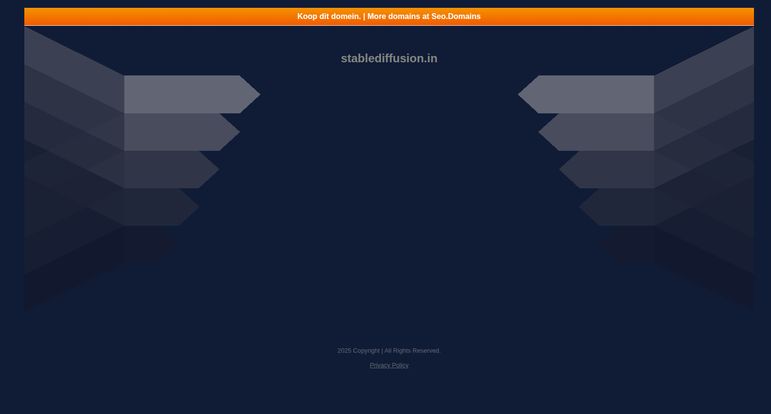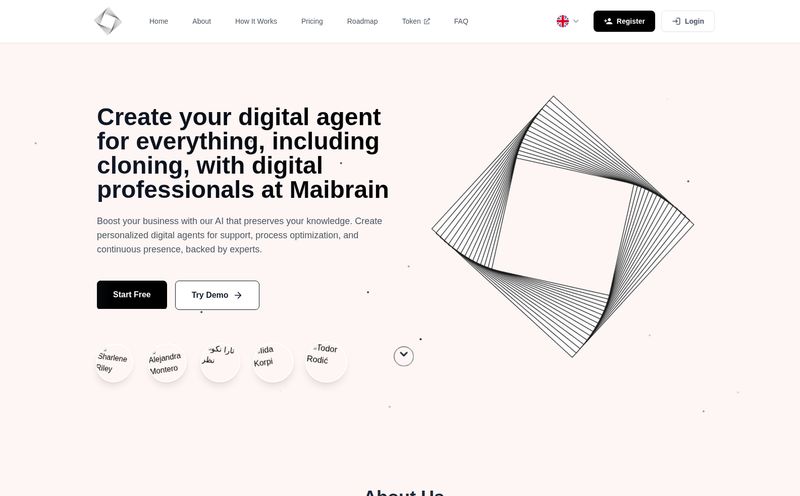I’ve been in the SEO and digital trends game for years, and the explosion of AI art generators has been a truly wild ride. One minute we’re optimizing for keywords, the next we're teaching machines to paint like Rembrandt. It's fantastic. And right at the center of this creative storm is a name you’ve probably heard whispered in the same breath as Midjourney and DALL-E: Stable Diffusion.
This isn't just another tool; it’s a foundational technology. A powerhouse. It promises to turn your wildest text descriptions into photorealistic images in seconds. A cat in a spacesuit? Done. A cyberpunk city street drenched in neon rain? Easy. But as with anything that gets popular this fast, the landscape can get a bit... messy. There's a lot of noise out there, and finding the real signal can be tricky. So let’s talk about what Stable Diffusion really is, what it can do for you, and—importantly—where to find the real deal.
So, What on Earth Is Stable Diffusion Anyway?
Alright, let's get the techy bit out of the way, but I'll make it painless. Promise. At its heart, Stable Diffusion is a latent text-to-image diffusion model. Sounds complicated, right? It’s not as bad as it sounds.
Imagine you have a block of fuzzy, staticky TV noise. A complete mess. Now, imagine a hyper-intelligent sculptor who can see a masterpiece hidden inside that noise. You whisper your idea—your prompt—into the sculptor’s ear: “a stunningly beautiful portrait of a queen, art by artgerm and greg rutkowski, 8k.” The sculptor then meticulously chips away at the static, bit by bit, refining the chaos based on your instructions until that stunning portrait emerges. That's basically what Stable Diffusion does. It starts with noise and ends with art.
The biggest thing to know is that it's an open-source project, primarily backed by a company called Stability AI. This is a game-changer. Unlike some of its more walled-off competitors, its open nature means developers can build on it, modify it, and even run it on their own hardware. It’s the Linux of the AI art world, in a way.
The Allure of AI-Generated Art
So what can this magical sculptor actually create? The provided info says it’s loved by users worldwide, and I can see why. It's not a one-trick pony.
From Simple Text to Photorealism
This is the main event. The ability to generate stunning, photo-quality images is Stable Diffusion’s bread and butter. The creative freedom here is just immense. You’re not just limited to simple phrases; you can stack details like you're ordering a complicated coffee. Think about adding styles like “in the style of Van Gogh,” or technical specs like “cinematic lighting,” “8k resolution,” or “hyper-detailed.” The more specific you are, the more the AI has to work with.

Visit Stable Diffusion Web
Creating Your Digital Twin with AI Avatars
You’ve seen them all over social media. Those impossibly cool, stylized portraits of your friends as astronauts, fantasy heroes, or pop art icons. Many platforms that use Stable Diffusion have integrated AI avatar generation. You upload a few photos of yourself, and the model retrains itself on your likeness to create a whole new set of profile pictures. It's a fun, if slightly vain, application of the tech.
Breathing New Life into Old Photos
This one really gets me. Stable Diffusion also has features for photo restoration. Got a faded, cracked photo of your grandparents from the 50s? This technology can help restore faces, fix damage, and bring a bit of clarity and life back to cherished memories. It's a genuinely heartwarming use case that goes beyond just making cool art.
Okay, A Necessary Detour: Where Do I Actually Use It?
Now for the crucial part. Naturally, when I was preparing to write this, I looked up a likely domain: `stablediffusion.in`. I typed it in, hit enter, and was greeted by… well, a for-sale page. The screenshot I took says it all. The top banner, in Dutch of all things, says "Koop dit domein," which means "Buy this domain."
This is a classic case of a parked domain. Someone registered a desirable name and is just sitting on it, hoping to sell it, plastering it with ads in the meantime. This is not an official platform. This is the boarded-up window I mentioned earlier, not the front door.
This happens all the time in high-growth tech areas. It's a reminder to be a little skeptical. The real power of Stable Diffusion isn't tied to one specific URL. It’s an engine, and you need to find a car that has it installed.
The Real Homes of Stable Diffusion
So if that domain is a dead end, where do you go? This is where the open-source nature is a blessing. You have options!
For the Tech-Savvy: Running It Yourself
If you have a decent gaming PC with a good graphics card (specifically an NVIDIA one with plenty of VRAM), you can run Stable Diffusion locally. This gives you maximum freedom, no censorship, and no credit costs. It requires some technical know-how to set up, involving things like GitHub and command lines, but the online communities have created some amazing one-click installers. It's the most poweful way to use the tool, but also the most demanding.
For Everyone Else: Web-Based Platforms
This is the easiest route. Several websites have built user-friendly interfaces on top of the Stable Diffusion model. They handle all the complicated server-side stuff, and you just get to have fun creating. A great place to start is DreamStudio, which is the official web app from Stability AI itself. Other popular choices include Playground AI and NightCafe Creator, each with their own unique features and community.
The Cost of AI Creativity
This is always a big question. How much does it cost? Since there’s no official pricing for a dead-end domain, let’s talk about the real-world models.
If you run it locally, it's free, apart from your electricity bill. For the web platforms, the pricing is almost always a credit-based system. When you sign up, they’ll typically give you a handful of free credits to play with. Each image generation will cost a certain number of credits, with costs varying based on image resolution, number of steps, and other advanced settings. Once your free credits run out, you can buy more in bundles. I've always felt this is a pretty fair model, as you only pay for what you actually generate.
A Quick Word on Crafting Good Prompts
Just because the AI is smart doesn't mean you can be lazy. The quality of your output is directly tied to the quality of your input. “A dog” will get you a dog, sure. But it might be a weird, six-legged, Picasso-esque dog.
The art is in the detail. Try this instead: “An adorable Corgi puppy sitting in a field of wildflowers, golden hour lighting, sharp focus, photo by Annie Leibovitz, extremely detailed.” See the difference? You’re giving the AI style, context, lighting, and artistic inspiration.
Also, don’t forget about negative prompts. These are things you tell the AI to avoid. Common ones include “ugly, blurry, deformed, disfigured, poor quality, bad anatomy.” It helps steer the AI away from common pitfalls and cleans up your results significantly.
Final Thoughts
Stable Diffusion is more than just a tool; it's a creative movement. It represents a shift towards democratized art creation, where the only limit is your imagination (and your ability to describe it). It’s powerful, versatile, and thanks to its open-source roots, incredibly accessible.
Just be smart about where you use it. Don't fall for parked domains or sketchy sites. Go to the established sources like DreamStudio or take the plunge and run it yourself. The world of AI art is waiting for you. Go make something amazing.
Frequently Asked Questions
- What is the difference between Stable Diffusion and Midjourney?
- The biggest difference is their model. Stable Diffusion is open-source, meaning it can be run locally and integrated into many different apps. Midjourney is a closed, proprietary service accessed primarily through Discord. Aesthetically, many feel Midjourney has a more polished, artistic default style, while Stable Diffusion offers more raw control and realism.
- Is Stable Diffusion free to use?
- Yes and no. It's free if you have the hardware and technical skill to run the open-source model on your own computer. If you use web-based platforms, they typically offer a certain number of free credits to start, with options to purchase more.
- Do I need a powerful computer to use Stable Diffusion?
- Only if you want to run it locally on your own machine. If you use web-based interfaces like DreamStudio, all the processing is done on their servers. You can generate images on a laptop, tablet, or even your phone.
- Can I sell the art I create with Stable Diffusion?
- This is a complex and evolving area of copyright law. Generally, images created on most Stable Diffusion platforms (especially using the base open-source models) are considered public domain or have very permissive licenses allowing for commercial use. However, you should always check the specific terms of service for the platform you are using. This is not legal advice!
- What's the secret to photorealistic images?
- It's all in the prompt! Use keywords like “photorealistic,” “hyperrealistic,” “8k,” “sharp focus,” and specify camera lenses or film types (e.g., “35mm lens”). Also, naming professional photographers in the prompt can heavily influence the style. And don't forget to use negative prompts to remove things like “cartoon, painting, illustration.”
Reference and Sources
- Stability AI: The company behind Stable Diffusion.
- DreamStudio: The official web interface for creating with Stable Diffusion.
- Stable Diffusion on GitHub: For those who want to see the source code or run it locally.



